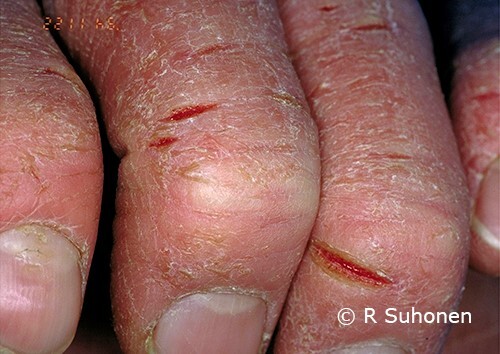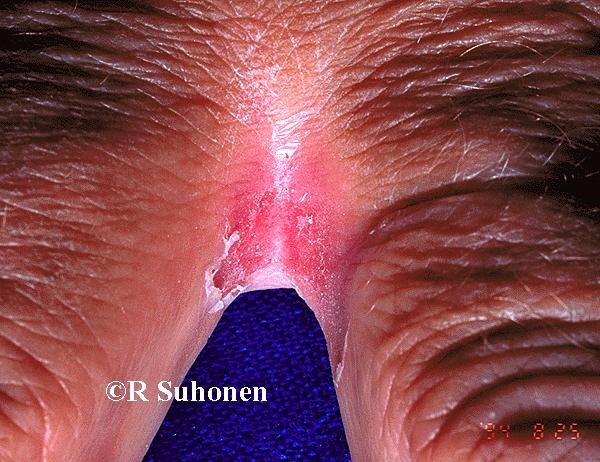What is it about ?
Contact dermatitis is inflammation of the skin triggered by an external agent, which activates the skin’s immune system. Inflammation is accompanied by redness and itching. People with sensitive skin and allergic predispositions are at greater risk of developing contact dermatitis.
Irritating chemicals can damage the skin and trigger an inflammatory reaction when exposure is sufficiently intense and prolonged. The main responsible factors are detergents, solvents and repeated hand contact with water.
Where and how often?
In the population over the age of 4, irritant contact dermatitis affects about one in 30 to 35 people. It is found mainly in certain occupational categories, including kitchen, cleaning, health care, salon workers. hairdressing, etc.
How to recognize it?
The condition is often manifested by redness, peeling skin (peeling) and itching of the hands (photo 1). Dermatitis begins between the fingers (photo 2) and on the back of the hand, before spreading to the palm.
photo 1: contact dermatitis on the hands

photo 2: contact dermatitis between the fingers

How is the diagnosis made?
Diagnosis is made on the basis of symptoms and identification of irritants. The doctor will ask you questions to find the irritants to which you are exposed and to assess the progression of the condition when you are no longer exposed to these agents, for example when you are a few days in leave.
If the lesions have not disappeared after 3 months of treatment, the doctor will order additional examinations. A fungal infection (yeast infection) can be diagnosed by examining the dander (skin dandruff) under a microscope. The doctor will refer you to a skin specialist (dermatologist) to rule out an allergy. The tests that can be carried out in this context are, for example, patch tests, which consist in putting certain allergens in contact with the skin of the back, and prick-tests, which consist in making a small incision (cuti ) on the forearm and put a few drops of different allergen extracts there.
What can you do ?
By starting treatment early, you will prevent the condition from becoming chronic.
- Limit or avoid exposure to agents that could irritate your hands.
- Protect your hands appropriately (wear cotton gloves and protective gloves on top).
- Avoid conventional soaps and wash your hands with neutral soap.
What can your doctor do?
Depending on the severity of the condition, the doctor will prescribe a more or less powerful cortisone cream, to be applied once or twice a day to the lesions until they disappear (2 to 6 weeks).
After the lesions have healed, it is often necessary to continue applying the cortisone cream twice a week, for 1 to 3 months, in order to prevent their recurrence.
Immunosuppressive therapy may be useful in cases of allergic predisposition.
If the contact dermatitis is related to the profession exercised, the doctor will prescribe a work stoppage for the duration necessary to cure the affection, unless it is possible to (temporarily) change the working conditions. The doctor will schedule a follow-up appointment at the end of the sick leave.
Want to know more?
- Allergological assessment (patch tests or prick tests), here, Where to find on this page of Cliniques St Luc UCL
- Corticosteroids for the skin – CBIP – Belgian Pharmacotherapeutic Information Center
Source